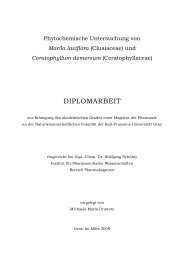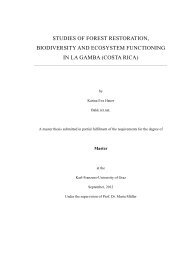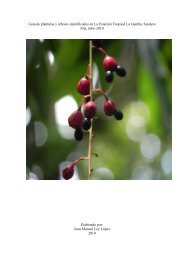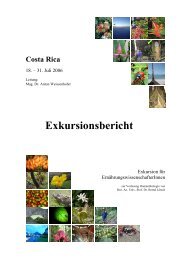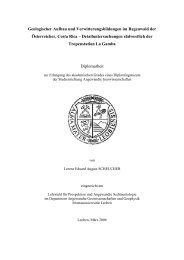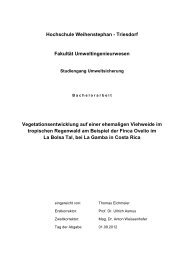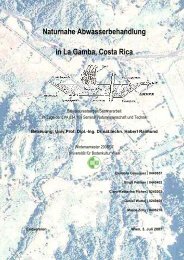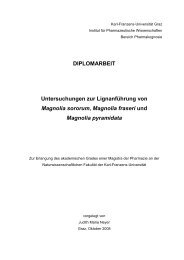Leaf colour patterns, vegetative and sexual reproduction of Episcia ...
Leaf colour patterns, vegetative and sexual reproduction of Episcia ...
Leaf colour patterns, vegetative and sexual reproduction of Episcia ...
You also want an ePaper? Increase the reach of your titles
YUMPU automatically turns print PDFs into web optimized ePapers that Google loves.
Figure 27 <strong>Episcia</strong> lilacina; left: flower in male stage; right: flower in female stage.<br />
Discussion: Prot<strong>and</strong>ry – like in <strong>Episcia</strong> lilacina – is quite common in the family <strong>of</strong><br />
Gesneriaceae (Denham 2004). It poses an effective method to avoid self-pollination.<br />
Observations <strong>of</strong> the longevity <strong>of</strong> individual flowers are scarce (Wiehler 1983). As noted by<br />
Primack (1985), the length <strong>of</strong> time the anthesis lasts can influence its total number <strong>of</strong> pollinator<br />
visits, which, in turn, can affect the amount <strong>and</strong> diversity <strong>of</strong> pollen a flower receives <strong>and</strong> the<br />
amount <strong>of</strong> pollen it disseminates. A period <strong>of</strong> 4 days <strong>of</strong> anthesis is stated for the species <strong>of</strong><br />
Drymonia (Endress 1994). Primack (1985) indicates a longevity <strong>of</strong> averaged 1.3 days with a range<br />
<strong>of</strong> 1-3 days for tropical rain forests. Due to the fact that <strong>Episcia</strong> lilacina’s flowers can be easily<br />
damaged by environmental influences but even though feature a two to three days timeframe for<br />
the anthesis the flowers can be considered durable above average.<br />
Over 80% <strong>of</strong> the flower species tested by Primack (1985) showed a male stage much shorter<br />
than the female one. Due to Primack this is caused by the fact that the usefulness <strong>of</strong> the male<br />
flowers to the plant is over as soon as the pollen is shed <strong>and</strong> that may occur in many species<br />
within hours after the flower has opened.<br />
Because the male as well as later on the female stages begin in the early morning the<br />
legitimate pollinator has to be day-active. Thus Noctuidae (moth) <strong>and</strong> Sphingidae (hawkmoth)<br />
can be excluded due to their overly night-active nature (Endress 1994). As stated by Faegri <strong>and</strong><br />
Pijl (1979), the diurnal anthesis without closing at night favours butterflies (Rhopalocera) as<br />
pollinators. Opler (1983) claims that most butterflies feed on nectar between 8.00 <strong>and</strong> 15.00,<br />
beginning later <strong>and</strong> stopping earlier than other diurnal nectarivores. Other authors (Roubik 1989,<br />
Armbruster <strong>and</strong> McCormick 1990) allege that the early morning is a major foraging time for bees.<br />
Therefore, many bee flowers open at that time or earlier during the night. This statement<br />
concerning psychophilous flowers is in contrast to <strong>Episcia</strong> lilacina because the opening <strong>of</strong> the bud<br />
as well as the beginning <strong>of</strong> the female stage occurs early in the morning <strong>and</strong> still in the night,<br />
60



